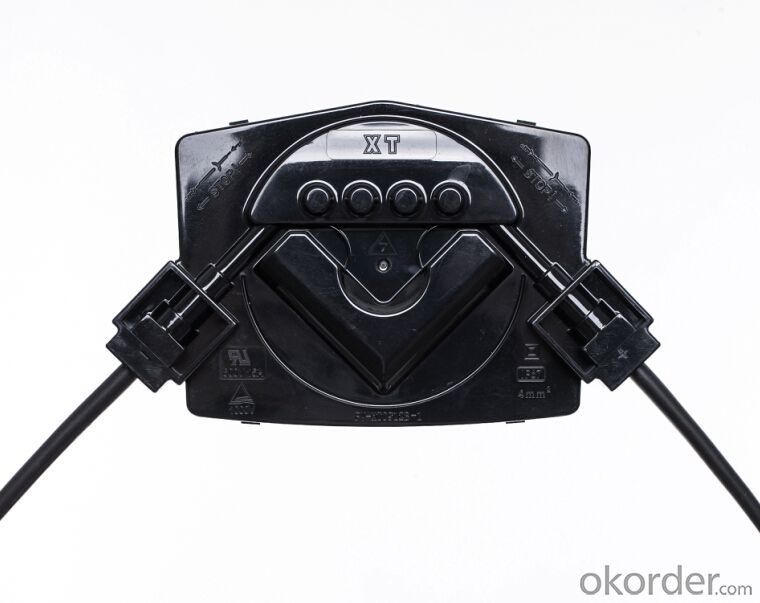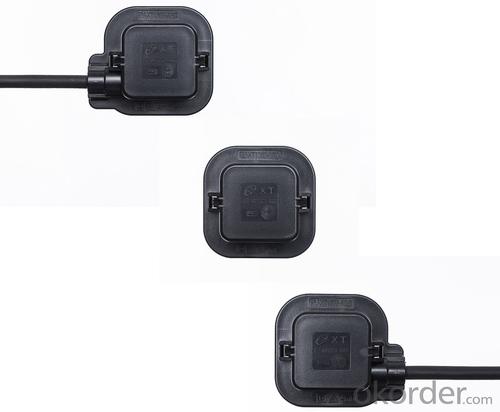Solar Energy Systems Ulverston PV Junction Box PV-1302 Split Design for Shortened Wiring - TUV, UL, ISO9001 Certified
- Loading Port:
- Guangzhou
- Payment Terms:
- TT OR LC
- Min Order Qty:
- 3000 pc
- Supply Capability:
- 3000000 pc/month
OKorder Service Pledge
OKorder Financial Service
You Might Also Like
Feature
a. split design, shortening wiring
b.use glue, excellent heat output
c. way of outlet, down and side optional
d.suitable for application of BIPV
Product description
1. All the connection made by double fixed connection low power loss
2. With the capacity of anti-aging and resistance to ultraviolet radiation on the outer cover with excellent box design with good thermal dissipation
3. Demonstrating safe, realiable and excellent lasting functionality, applicable in harsh outdoors working ambient
4. Big variety for choices,1 rail ,2 rail,3 rail,4 rail,5 rail,6 rail.mini junction box and solar junction box for solar street light

Item | Data |
Terminals for Ribbons | 2 |
Rated Current | 12A/15A |
Rated Voltage | 1000V/1500V |
Dimension | 67.4*51*15.5mm |
Temperature | -40℃~+85℃ |
Size of Cables | 4 mm2/12AWG |
Size of Ribbons | W(6±2mm)*T(0.3±0.15mm) |
Protection Degree | IP67 |
Flammability Class | V-0 |
FAQ
1. How long will my inquiry get response?
Your inquiry related to our products or prices will be replied within 24 hours.
2. Can I get professional service and suggestion?
Well-trained and experienced staffs to answer all your questions in fluent English.
3. Do you accept OEM or customized design?
OEM & ODM, any your customized lightings we can help you to design and put into product.
4. What if I need specific design?
Distributorship are offered for your unique design and some our current models.
- Q: Are there any environmental benefits of solar energy systems?
- Solar energy systems provide a multitude of environmental advantages. To begin with, solar energy is a pristine and sustainable source of power. It releases no greenhouse gases or other harmful pollutants into the atmosphere, thus diminishing air pollution and fighting against climate change. Solar power accomplishes this by generating electricity without producing any carbon emissions. Moreover, solar energy systems necessitate minimal water usage when compared to conventional energy generation methods like coal or natural gas power plants. This is especially crucial in regions where water scarcity or droughts are prevalent, as solar power aids in the conservation of water resources. Additionally, solar energy systems help decrease our dependence on finite fossil fuels, which contribute to the depletion of our natural resources. By harnessing electricity from sunlight, solar power diminishes the necessity for extracting and burning fossil fuels, thereby preserving these valuable resources for future generations. Furthermore, solar energy systems can be effortlessly installed on rooftops or in open areas, reducing the need for extensive land clearance or the destruction of habitats. This measure safeguards ecosystems and preserves biodiversity. In conclusion, solar energy systems provide substantial environmental benefits by reducing greenhouse gas emissions, conserving water resources, reducing reliance on fossil fuels, and safeguarding ecosystems. By transitioning to solar power, we can contribute to a cleaner and more sustainable future for our planet.
- Q: How can I calculate the size of a solar energy system for my home?
- In order to determine the size of a solar energy system for your home, several factors need to be taken into consideration. The following steps can be followed: 1. Begin by analyzing your past energy bills to understand your average monthly energy usage in kilowatt-hours (kWh). This will provide an indication of the amount of electricity your solar system should generate. 2. Evaluate your location, as the amount of sunlight your home receives is dependent on its geographical position. Consult the solar resource map for your area to estimate the average daily solar radiation. This information will assist in determining the efficiency of the solar panels. 3. Calculate your energy requirements by multiplying your average monthly energy usage in kWh by 12 to obtain your annual energy consumption. Then divide this figure by 365 to determine your daily energy consumption. 4. Determine the output of the solar panels by considering their wattage rating, which indicates the amount of power they can generate under ideal conditions. Divide your daily energy consumption by the average daily solar radiation to estimate the number of solar panels required. For example, if your daily energy consumption is 40 kWh and the average daily solar radiation is 5 kWh/m2, you would need an 8 kW solar system (40 kWh / 5 kWh/m2 = 8 kW). 5. Take into account system losses, which occur due to factors such as shading, dirt, and inefficiencies in the inverter. To compensate for these losses, multiply the estimated system size by a derating factor, which typically ranges from 0.75 to 0.9. This will provide the final system size required. 6. Seek guidance from a solar energy professional or installer, as it is advisable to consult with an expert who can conduct a site assessment and provide accurate calculations based on your specific home and energy needs. They will consider additional factors such as roof orientation, available space, and local regulations to ensure the optimal size of the solar system for your home. Keep in mind that the size of your solar energy system is also influenced by your objectives, budget, and available space. A professional consultation will enable you to make an informed decision and maximize the advantages of solar energy for your home.
- Q: What is the expected return on investment for a solar energy system?
- The expected return on investment for a solar energy system can vary depending on several factors such as the initial cost, location, available incentives, and energy usage. Generally, a solar energy system is expected to provide a positive return on investment over its lifetime. The initial cost of installing a solar energy system can be a significant investment, including the cost of solar panels, inverters, and installation. However, with the decreasing costs of solar technology in recent years, the upfront expense has become more affordable. The location of the solar energy system plays a crucial role in determining the expected return on investment. Areas with higher solar irradiance and longer sunshine hours tend to generate more electricity, resulting in a higher return. Additionally, the availability of net metering policies, which allow excess electricity to be fed back into the grid and credited to the owner, can further enhance the return on investment. Incentives and subsidies provided by governments and local authorities can significantly impact the expected return on investment. Many countries offer tax credits, grants, and rebates to encourage the adoption of solar energy systems. These incentives can reduce the initial cost and accelerate the payback period, enhancing the overall return on investment. Furthermore, the energy usage of the property is a critical factor in determining the expected return on investment. Higher electricity consumption means a greater opportunity for the solar energy system to offset utility bills, resulting in higher savings and an improved return on investment. While the specific return on investment can vary, studies have shown that solar energy systems typically pay for themselves within 5 to 10 years and continue generating free electricity for several decades. This extended period of energy production allows for significant savings on utility bills and a positive return on investment over the system's lifetime. Overall, investing in a solar energy system can provide long-term financial benefits through reduced electricity costs, potential revenue from excess electricity generation, and increased property value. It is crucial to perform a thorough evaluation considering the specific factors mentioned above to determine the expected return on investment for a solar energy system in a particular scenario.
- Q: Can a solar energy system be used in areas with high levels of air pollution?
- Yes, a solar energy system can still be used in areas with high levels of air pollution. While air pollution may affect the efficiency of the solar panels to some extent, they can still generate electricity. However, it is important to regularly clean and maintain the panels to ensure optimal performance. Additionally, investing in advanced air filtration systems can help mitigate the impact of air pollution on the solar energy system.
- Q: What is the role of power optimizers in solar energy systems?
- Power optimizers in solar energy systems play a crucial role in maximizing the efficiency and performance of the system. They are responsible for individually optimizing the power output of each solar panel, allowing them to operate at their maximum potential, despite shading or other performance limitations. By continuously monitoring and adjusting the output of each panel, power optimizers help to improve the overall energy yield, increase system reliability, and enhance the overall return on investment for solar installations.
- Q: Can solar energy systems be used in cloudy or rainy areas?
- Yes, solar energy systems can still be used in cloudy or rainy areas. While solar panels do produce less electricity in cloudy or rainy conditions compared to sunny conditions, they can still generate power. Additionally, advancements in solar technology have made panels more efficient in low-light conditions, allowing them to harness energy even in cloudy or rainy areas.
- Q: How much space is needed for installing a solar energy system?
- The amount of space needed for installing a solar energy system varies depending on various factors such as the size of the system, the type of solar panels used, and the energy requirements of the property. Generally, for residential installations, a typical rooftop solar system requires around 100 to 400 square feet of space. However, it is recommended to consult with a professional installer who can assess the specific requirements of your property and provide accurate information on the space needed for a solar energy system.
- Q: Are there any tax credits available for solar energy systems?
- Yes, there are tax credits available for solar energy systems. The federal government offers a federal solar investment tax credit (ITC) that allows homeowners and businesses to deduct a percentage of the installation cost of a solar energy system from their federal taxes. Additionally, some states, local governments, and utility companies may also offer their own tax incentives for solar energy systems.
- Q: How much space is required for a solar energy system?
- The space required for a solar energy system varies depending on factors such as the size and capacity of the system, the type of solar panels used, and the amount of energy needed. Generally, a typical residential solar energy system requires anywhere between 100-400 square feet of roof space for installation. However, ground-mounted systems or larger commercial systems may require significantly more space. It is recommended to consult with a solar energy professional to determine the specific space requirements for your desired system.
- Q: Can solar energy systems be used for powering off-grid research stations in Antarctica?
- Yes, solar energy systems can be used for powering off-grid research stations in Antarctica. Solar panels can be installed to capture sunlight and convert it into electricity, which can then be stored in batteries for use during periods of low sunlight. This renewable energy source is a viable and sustainable option for powering remote research stations in Antarctica, reducing reliance on fossil fuels and minimizing environmental impact.
Send your message to us
Solar Energy Systems Ulverston PV Junction Box PV-1302 Split Design for Shortened Wiring - TUV, UL, ISO9001 Certified
- Loading Port:
- Guangzhou
- Payment Terms:
- TT OR LC
- Min Order Qty:
- 3000 pc
- Supply Capability:
- 3000000 pc/month
OKorder Service Pledge
OKorder Financial Service
Similar products
Hot products
Hot Searches
Related keywords


























